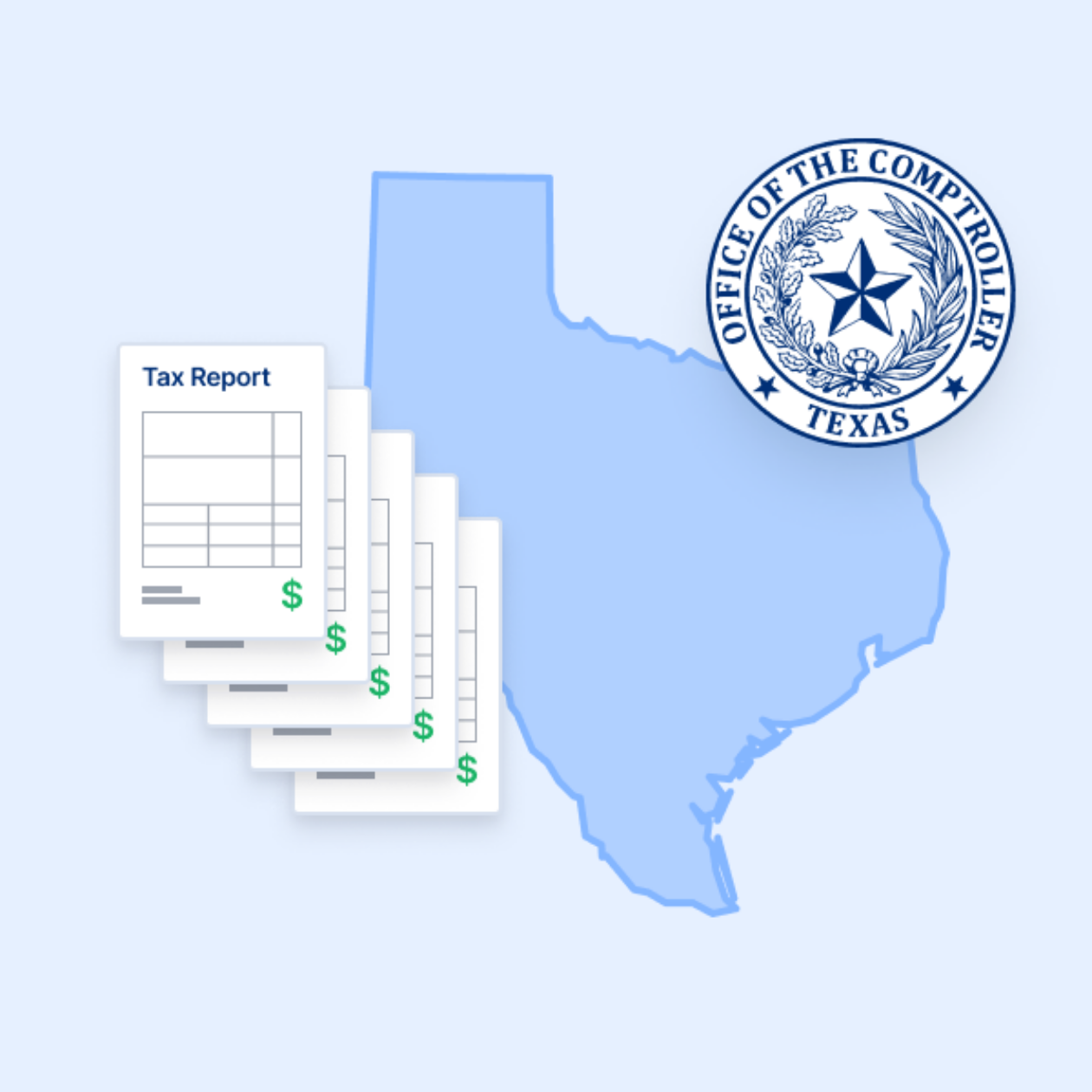
Every Texan business must focus on collecting taxes and remitting them to the state. This entire process of reporting sales taxes helps your business maintain legal compliance and avoid heavy penalties associated with delayed tax reporting or incorrect filing. Understanding and managing the process of Texas sales tax filing can be difficult for online sellers. That’s why you should use an online tool like TaxCloud to simplify the process and streamline sales tax compliance in Texas.
As per the latest regulations, the Lone Star State can levy sales taxes on businesses from 6.375% to 8.25%. That’s because the standard sales tax rate is 6.25%, and local jurisdictions are allowed to add an additional amount up to 2%. So, the sales tax rate is capped at 8.25% for Texan small businesses. Here’s why it’s important for you to report sales tax Texas:
- Compliance: If you fail to report it accurately or within the deadline, prepare to face a hefty fine from the state government ($50 for late submissions).
- Transparency: Sales tax isn’t your business revenue; it belongs to taxpayers. So, timely & accurate Texas sales tax filing will ensure that you’re not mismanaging these funds.
- Financials: If you don’t report your sales tax in time, you may face interest charges that keep accumulating over time. So, late filings will put a dent in your finances.
If you’re an online seller, you may struggle with the concept of “nexus,” which determines if you are even legally required to collect sales taxes in Texas. The physical presence of your business is usually a condition. However, the Supreme Court ruling in South Dakota v. Wayfair (2018) is monumental in this regard since it allowed taxes to mandate sales tax collection from sellers who had no physical presence in that state.
If you’re having trouble making sense of these laws, you can report sales tax Texas by utilizing TaxCloud’s automated services. TaxCloud makes it easier to calculate and collect sales taxes. It will reduce the risk of errors and save time, letting businesses focus on growth rather than sales tax compliance errors. TaxCloud offers a free 30-day trial for users to explore its features and see how it can simplify the reporting process while ensuring compliance with Texas regulations.
How to Report Sales Tax in Texas?
In this blog, we’ll discuss how to report sales taxes in the Lone Star State. But first, we need to go over some basic concepts so you can better understand compliance issues. Here are five very important things that you must understand before embarking on your sales tax reporting journey in Texas:
- Your filing frequency depends on your sales tax liability. It can be monthly, quarterly, or annually. Returns are normally due on the 20th of the month after the reporting period (in other words, you report April’s sales by May 20).
- If no sales taxes were owed during this reporting period, you may file zero returns. But it is important to file and report sales tax Texas returns even if you didn’t owe anything.
- As mentioned before, there’s a $50 penalty (or 10% of the taxes owed) if you don’t file your taxes before the deadline.
- As a seller, you’re the de facto sales tax collectors for Texas. So, you should collect the right amount of sales tax at the point of sale and later report these collections to the state government.
Keep in mind that sales taxes are a major source of income for the state of Texas. It amounts to a whopping 32% of state tax collections! In 2022, the state government reported sales tax revenue of over $46B, underscoring the importance of accurately reporting your taxes.
That’s why we’ll now discuss the process of reporting sales tax in Texas for online sellers. Read these six steps to learn how to ensure sales tax compliance Texas properly:
Step 1: Register Your Business
This journey will begin with you registering your business with the Texas Comptroller‘s Office. It is important to get a sales tax permit to begin reporting sales tax in Texas. You can simply visit the Comptroller’s website or submit the Form AP-201. After registering your business, you will get your permit number. You must display this number at your business place.
Now, you’re officially permitted to collect sales taxes and report them to the government.
Step 2: Determine Your Sales Tax Nexus
The term “nexus” means the connection your business has with the state of Texas. It will create a sales tax liability for your company. You can establish nexus by establishing your presence here either physically or economically. So, if you have an office/warehouse in Texas or if your annual sales are over $500,000, you have established this connection.
- Physical Presence Nexus: The physical presence of your business is self-explanatory. If you have a physical facility within the state, salespeople/agents, or warehouses, then you have established this nexus. Similarly, engaging in events like trade shows will make you liable to collect and report sales tax.
- Economic Threshold Nexus: As a remote seller, you establish nexus in Texas (thanks to South Dakota v. Wayfair) if your gross revenue from sales in the Lone Star State exceeds $500,000. Half a million in sales, and you’re liable to pay sales tax.
Step 3: Collect the Correct Sales Tax Rate
Keep in mind that the buyer’s location determines your sales tax rate. Your location doesn’t get to decide how much sales taxes you’ll pay. Many local jurisdictions can levy an additional 2% on top of the state-mandated 6.25%.
So, you may have to use the online sales tax rate locator by the Texas Comptroller to find out your sales tax rate. It’ll help you ensure sales tax compliance Texas.
You may also use a tool like TaxCloud to determine the correct tax rate based on buyer location.
Step 4: File Your Texas Sales Tax Report
You’ll usually pay these taxes on the 20th of the month following the reporting period. Also, the frequency of reporting will depend on your sales tax liability. It’s now very easy to file taxes in Texas. You have to use the eSystems platform to report your taxes. Even if no tax is due, you’ll still have to submit your return. Here’s what you must do:
- Create an account with the eSystems site by visiting their website.
- Click on the webfile login option to sign up as a first-time user.
- Log in to your account and enter your taxpayer number.
- Select the correct reporting period to start filing your taxes.
- Mention if you are eligible for tax credits or sales tax exemption.
- Enter your details in the sales tax return form and make the payment.
- Get a discount of 1.25% for prepayments made by monthly/quarterly taxpayers.
Taxpayers with more than $50,000 in sales tax liability are required to file their returns online using the eSystems platform. Don’t forget that you haven’t paid these taxes to the government yet; you’ve only reported them electronically.
Step 5: Pay Your Sales Tax Liability
After filing your sales tax return, you have to remit the taxes collected from buyers right away to the Texas Comptroller. You can either make online payments via the eSystems platform or by mail. We’ll explain both methods here very briefly.
If you exceed the $50,000 sales tax liability threshold, it’s necessary to use the eSystems method to pay the state government. For that, you have to:
- Log in to your eSystems account
- Select the reporting period and the payment type
- Enter the payment amount and your banking information
- Submit the payment
You can also remit your tax payment by mail. Just make your check or money order payable to the Texas Comptroller of Public Accounts. Don’t forget to include your taxpayer number there as well. Use this mailing address:
P.O. Box 149356
Austin, TX 78714-9356
Step 6: Keep Records of Your Sales Tax Filings
You should also keep detailed records of your Texas sales tax filing. Here are 3 major reasons why it is vital to maintain proper records of your tax payments:
- Compliance with Tax Laws: First, healthy record-keeping habits ensure compliance & agreement with the Lone Star State’s taxation-related laws. You can show how well you are adhering to these regulations by maintaining records like sales receipts, invoices, and exemption certificates.
- Preparing for Audits: Your business may face an audit when you least expect it. Having proper records of your sales tax payments will help you verify the accuracy of your sales tax filing/reporting records. It’s a great way to show auditors that you have remained fully compliant with local tax laws.
- No Financial Penalties: Lastly, you can avoid serious financial consequences by staying compliant and keeping all records. For example, if you fail to document all taxable sales accurately or do not keep track of exemption certificates properly, you may face fines for underreporting taxes owed.
Final Thoughts
In short, you have to report your sales tax in Texas to maintain compliance and avoid penalties. The Texas sales tax filing process may seem a little complicated. However, we’ve outlined the six necessary steps that make it way easier to file your sales taxes to the state government.
If you still have any issues, use TaxCloud to automate the sales tax filing/reporting process. This tool will make your life easier by automating many aspects of sales tax filing, e.g., determining the nexus, calculating your sales tax rate, filing taxes, and maintaining accurate records. You can easily avoid hefty penalties and enjoy the benefits of complying with state-mandated laws.
Get started with a free 30-day trial of TaxCloud today to streamline your sales tax compliance in Texas and beyond.
Join 15,000+ eCommerce owners
Stay informed on sales tax news — sign up for our free newsletter.
